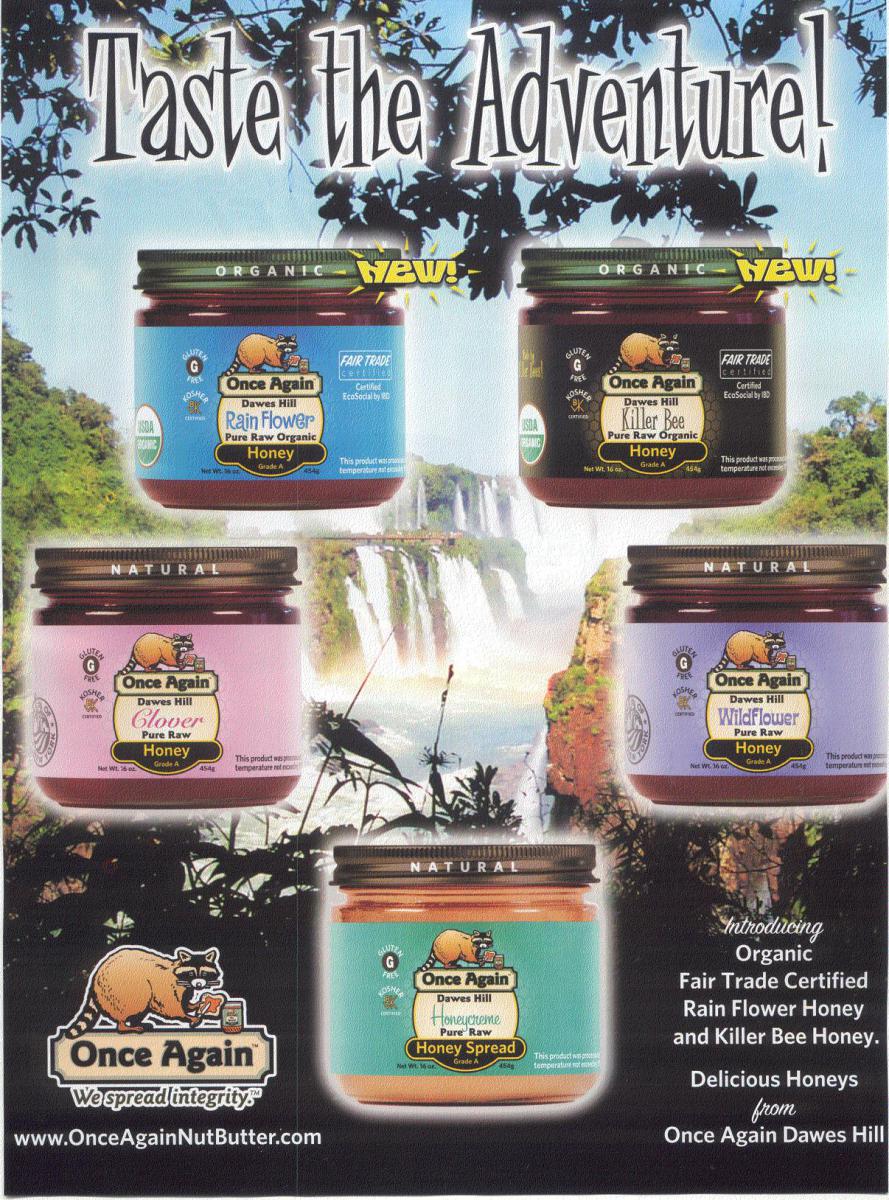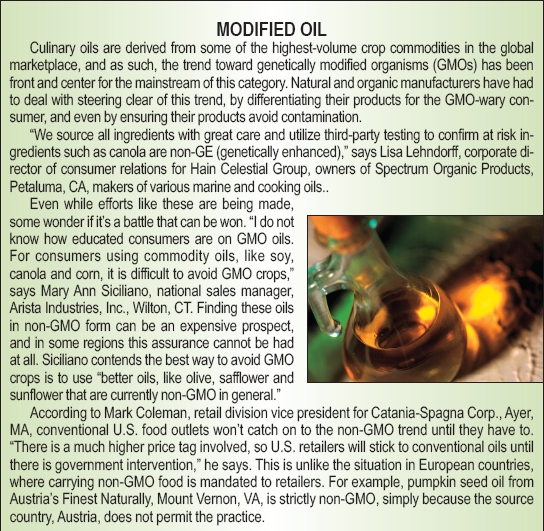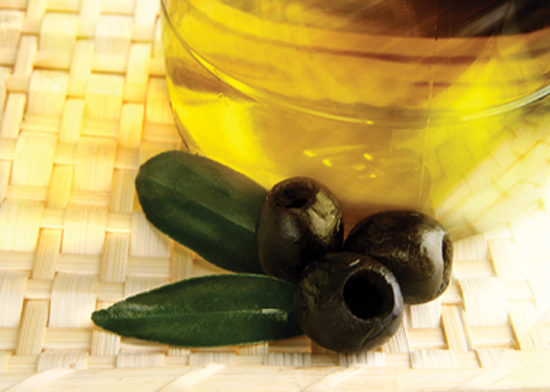Everyone likes to eat tasty food, and every human being needs to consume healthy fats. The influx of options in the healthy cooking oils category fills both needs amply. For their part, oil makers are eager to share their product knowledge with retailers, so that they in turn can give their customers the information needed for healthy cooking.
Everyone likes to eat tasty food, and every human being needs to consume healthy fats. The influx of options in the healthy cooking oils category fills both needs amply. For their part, oil makers are eager to share their product knowledge with retailers, so that they in turn can give their customers the information needed for healthy cooking.
Fats in Demand
The first and last consideration when it comes to determining the health profile of a cooking oil is its fat content. Is it a good fat, or a bad fat? This is the question health-conscious consumers ask themselves about the contents of any food nowadays, let alone the oil in which they’ll immerse their dinner. Of course, the good fats, those needed to support every aspect of overall health, stretch beyond the well-known essential fatty acids (EFAs), but get a bum rap because of the negative connotation of the word itself.
“Fat,” in the modern consumer’s mind, will always be associated primarily with bad cholesterol and its well-documented negative effects on cardiovascular health. So, there is always the danger of confusing these nefarious fats with the necessary ones. But luckily, clinical research is continuing to clear things up, and healthy oil makers are happy to emphasize this fact.
Coconut oil. “Recent research on coconut oil showed that it raised HDL cholesterol and lowered LDL cholesterol, and helped reduce abdominal obesity,” says Jonny Bowden, Ph.D., author and member of the nutritional advisory board of Barlean’s, Ferndale, WA, makers of organic flax and marine oils (1). HDL stands for high-density lipoprotein, and is commonly referred to as “good” cholesterol, whereas its low-density counterpart is associated with many forms of cardiac disease.
Coconut oil is characterized by its saturated fat content. While in some circles it has suffered from a poor reputation along with other cooking oils, consumers are coming to recognize it for the healthful plant-based option that it is, according to Erin Meagher, founder of Kelapo Coconut Oil, Tampa, FL.
The attention coconut oil is getting is well-deserved, says Lisa Lehndorff, corporate director of consumer relations for Hain Celestial Group, owners of healthy oil maker Spectrum Organic Products, Petaluma, CA. “Coconut oil is increasing in popularity right now because it is a natural source of medium-chain triglycerides (MCTs) which are more readily metabolized than other fats. They digest easily, producing energy and supporting the body’s metabolism,” she says.
Olive oil. Calling it the cornerstone of a healthy diet, Al Hamman, owner of Hamman Marketing Associates, Johnson City, TN, U.S. marketing agency for 100% Tunisian Olive Oil, says, “The health benefits of olive oil consumption could fill a book.” Composed primarily of monounsaturated fat, Hamman says olive oil provides great taste and is easy to digest, making it a go-to alternative to less healthy culinary oils. Olive oil contains two EFAs, meaning that the body is unable to produce them itself: linoleic acid, an omega-6 fatty acid, and alpha linoleic acid, an omega-3. Olive oils also contain polyphenols, vitamin E and other natural antioxidants, making it the ongoing subject of diverse research into its potential health benefits.
An integral component of the popular Mediterranean diet, olive oil is linked to improvements in diabetes, cholesterol, obesity and colon cancer. To top it all off, Hamman says, “The Mayo Clinic recently repeated the U.S. Food and Drug Administration’s assertion that consuming about two tablespoons (23 grams) of olive oil a day may reduce your risk of heart disease.”
Indeed, the olive oil and heart health connection has been among the most popular marketing claims in the category, states Mary Ann Siciliano, national sales manager, Arista Industries, Inc., Wilton, CT, manufacturers of various natural vegetable and marine oils. According to Siciliano, it is the monounsaturated fat oleic acid, present in olive and many other oils, which may be responsible for proven cardiovascular benefits. Oleic acid has, in fact, been found to lower blood pressure (2). Lehndorff adds that the monounsaturated fat in olive oil helps regulate cholesterol levels, delivering a superior ratio of protein to cholesterol.
Yet, benefits to other areas like cancer, weight management and immune and digestive health are being explored in connection with the consumption of olive oil and other healthy oils. “Healthy seed oils like sesame, sunflower, safflower, flax, canola, olive and peanut help manufacturers eliminate trans-fat,” Siciliano says. The feared trans-fatty acids, though now banned from food sold in many locations, are still present in large quantities in many processed foods. These fats can be avoided by using healthy oils with less harmful forms of unsaturated fat.
Other oils. Oil derived from pumpkin seeds is powerful stuff as well. “The Austrian pumpkin is a special pumpkin,” says Christa Cook, vice president of marketing and sales, Helco Ltd., Mount Vernon, VA, importer and distributor of pumpkin seed oil brand Austria’s Finest Naturally. Their variety comes from the Styrian pumpkin, listed in the Botanical Registry as Cucurbita pepo L. Convar. Pepo var. styriaca GREB. Containing the entire range of omega fatty acids—3, 6 and 9—as well as vitamin E and no trans-fat whatsoever, pumpkin seed oil is a highly nutritious non-cooking culinary oil.
 According to Cook, the oil is 40% linoleic acid, one of the two consensus EFAs, the other being alpha-linolenic acid.
According to Cook, the oil is 40% linoleic acid, one of the two consensus EFAs, the other being alpha-linolenic acid.
When made a part of the diet, “the benefits of this very healthy, non-hydrogenated oil, are evident in healthy skin, hair and nails,” says Cook, adding that it is often used in topical cosmetics as well. Resulting in an oil that is dark green in color and possesses a nutty smell and taste, pumpkin seeds (which are high in zinc) have been associated with prostate and general glandular health as well as reduction in inflammation. Cook also says the oil is linked with improving digestive issues.
Those looking for nutritious benefit from their cooking oil should not neglect nut oils. “Like the nuts they come from, nut oils are very low in saturated fats,” says Siciliano. She cites some other positive traits of certain nut oils, including:
• Almond, hazelnut, macadamia, pecan and pistachio oils are high in monounsaturated fats.
• Walnut oil is high in polyunsaturated fats and also supplies omega-3 fatty acids.
• Almond and hazelnut oils are significant sources of vitamin E.
Oils renowned for their omega-3 fatty acid content, but limited in their use as culinary oils, can still find their way into dishes like salad, or wherever a creative chef can employ them in ways that don’t require heating. Oils that fall under this umbrella include fish and flaxseed oil. “Omega-3s have significant, demonstrated benefits on heart health. They lower triglycerides and to some extent blood pressure, and they significantly reduce inflammation, which is a ‘silent killer’ and major contributor to heart disease (as well as to Alzheimer’s, obesity, diabetes, arthritis, etc.),” Bowden says.
Pressing Concerns
Meagher maintains that the best method of extraction for coconut oil is cold-expeller pressing, saying, “It maintains the high levels of the lauric acid found within coconut oil, while leaving a great taste and aromatic smell.” This is often the preferred method, because avoiding high-heat extraction methods, like centrifuging, can allow an oil to retain its full nutritional benefits in finished form. In addition, “studies report that when using centrifuged coconut oil on sweet dishes, a distinct soapy after taste can be detected,” Meagher says.
Lehndorff notes the distinction between the usual extraction methods, stating, “Expeller pressing is a mechanical rather than chemical extraction process. This method results in no solvent (such as hexane or other petroleum-based solvents) left in the oil, and provides natural and healthy oils.”
Hamman explains that the marketing of oils is often tied to extraction method and the associated effects on the finished oil. “Almost all quality oils are extracted without heat, and are marked with the ‘cold press’ method,” on product labeling, he says. Although a majority of conventional oil manufacturers now use mills and centrifuges, other less-harsh methods are able to create oils with the highest chemical profiles for polyphenols, and offer a fruitier, more pungent taste.
“Cold-pressed oils produced without solvents are normally a preference, but many oils cannot be pressed without refining for added stability,” says Siciliano. “Excessive heat can most certainly damage the properties of some oils and breakdown important components,” she adds. Refining and filtering, Siciliano explains, are purification processes that are employed in part to enhance the visual quality and neutral taste of some oils.
 Though in order to create a nutty, roasted flavor, pumpkin seeds are heated in the oil manufacturing process, Cook maintains that at this temperature, there is no negative effect on nutrients like polyunsaturated fatty acids or vitamin E. The oil comes out of the centrifuge cold, then the oil and water are left to separate naturally.
Though in order to create a nutty, roasted flavor, pumpkin seeds are heated in the oil manufacturing process, Cook maintains that at this temperature, there is no negative effect on nutrients like polyunsaturated fatty acids or vitamin E. The oil comes out of the centrifuge cold, then the oil and water are left to separate naturally.
Certain oils are better suited to high-heat cooking than others, and guidance in this area is plentiful on the internet and from oil manufacturers. “Because of the stable properties of coconut oil, (one of the reasons coconut oil is solid below 78 degrees F), it won’t break down as easily as other oils,” Meagher says, after stating that the smoke point of unrefined coconut oil is 350° F. Bowden adds that, importantly, coconut oil “can stand up to high heat without forming any nasty compounds like trans fats.” About pumpkin oil’s culinary use, Cook says, “Because it is slightly roasted to create this pleasant flavor, it is a finishing oil, and should not be heated.” It is suited to being drizzled over salad, rice, pasta, vegetables, soups and other foods.
A Little Refinement
Methods of extraction and manufacture are often used to subdivide oils into niche categories. For instance, Lehndorff’s company offers a concept called 1-2-3 Cooking, comprised of guidelines to using the right oil to suit the need and situation. It organizes cooking oils into categories of use, including refined oil for high-heat cooking, unrefined oil for flavor and nutriment oil for health. “By using the right oil for the right reasons, you can preserve the healthful benefits of the oils and your foods will not only taste their best but also provide a healthy array of beneficial fatty acids,” Lehndorff says.
This breakdown indicates how the refinement (or lack thereof) of an oil can determine its attributes. By removing impurities, refinement tends to increase an oil’s stability (meaning a lower smoke point), while neutralizing its taste profile. Cooking with an oil tends to neutralize taste anyway, so a more refined oil may be suited to high-heat sautéing, for instance. To retain the distinctive and desired taste of olive oil, for example, manufacturers may avoid excessive refinement. Finally, there are those products designed to take advantage of the most robustly nutritious variety of a particular oil possible, and can be used in food without added heat or as dietary supplements.
Some consumers will become overzealous with their favorite healthy oil. Since olive oil is considered healthy, explains Lehndorff, many people will try to use it in too many cooking situations. “Olive oil is very sensitive to heat. It will smoke around 300° F and therefore should only be used for light sautéing,” she states. Lehndorff emphasizes one point for the proper use of any cooking oil, saying, “The primary recommendation we have for cooking is not to exceed the smoke point of any specific oil. Doing so degrades the oil and damages the flavor of the food.”
Storage tips. Just as oils vary in areas like smoke point and nutritional content, they also vary in terms of shelf life. Lehndorff says her company recommends storing oils in a refrigerator which, though not necessary, can prolong shelf life. Coconut oil is stable enough to stay fresh for up to two years, if stored properly in a pantry or refrigerator. “It actually can go back and forth between a solid and liquid and stay fresh and ready for use,” Meagher says. Pumpkin seed oil, according to Cook, can enjoy a shelf life of 12 months when sealed properly.
Make sure not to overbuy cooking oils, experts advise. “Buy quantities that match your usage, so that your olive oil is robust, healthy and flavorful,” offers Hamman. Heat, light and air are the enemies of olive oil, he says, so opened oil containers should be stored in a cool, dark place, with no direct exposure to a heat source or sunlight. Says Hamman, “Unlike wine, olive oil doesn’t improve with age, and once opened, can begin to turn rancid in as little as 30 days.”
Marketing director for Barlean’s Andreas Koch describes how his company’s oils come packaged with optimal storage in mind. “It is important that no light or heat penetrate the oil, which is why the black, opaque bottles are used. Due to its light weight, it is also the environmentally-friendly way to ship,” he says.
Oil Futures
Recent reports indicate that prices in the culinary oil market may be in for a spike. Weighing in heavily was Mark Coleman, retail division vice president for Catania-Spagna Corp., Ayer, MA. As makers of various olive, vegetable and organic oils, “we live with these market and crop issues every day,” he says, going on to identify several factors that may be responsible.
The first half of last year had prices in line to stay low in major categories like soy, canola and corn oil. But in the wake of the first negative crop report in August, the market spiked rapidly and has not recovered, according to Coleman. Specifically, an uncertain soy crop in Argentina due to early dry weather has price forecasts on the uptick. For the corn oil market in particular, the general turn away from high-fructose corn syrup has led to very strong demand for corn oil in the United States. Since the oil is a byproduct of corn, which is being produced in less volume, prices are being driven up.
Factors such as high crude petroleum prices ($88/barrel at the end of 2010) combined with ethanol and bio-diesel usage mandates, included in the recently passed Tax Bill, are affecting prices in this industry, according to Coleman. These fuels utilize alternative oils, thus driving prices in the market upwards. There is also the looming threat of China buying up large amounts of U.S. soy, corn and peanut oils.
To avoid the price fluctuations, companies should be contracting their needs ahead of time, Coleman argues, instead of waiting for the lowest possible price. “There is no need for any company to get caught completely on the short end of the stick,” he says. He adds that his company is hosting a culinary oils seminar on April 11 of this year, free of charge for companies looking for education in the buying market.
Other oil makers are aware of the issue, as Meagher explains that fluctuations are a part of the business. “Dry conditions last year and then heavy rains this year have led to lower crop production in India and the Philippines. In addition, the international demand for coconut oil has steadily increased, driving the price to almost double in the last year.”
Sicilano says of the situation, “Most suppliers should be aware of this, but manufacturers and consumers see the new higher prices they are paying and many times do not know the reason behind it.” Simple consumer demand, of course, is also a constant driver of price, and one that retailers will surely benefit from in the contemporary culinary oils market. WF

References
1. M. Assunção, et al., “Effects of Dietary Coconut Oil on the Biochemical and Anthropometric Profiles of Women Presenting Abdominal Obesity,” Lipids, 44(7), 593-601 (2009).
2. S. Terés, et al., “Oleic acid content is responsible for the reduction in blood pressure induced by olive oil,” Proc. Natl. Acad. Sci. USA, 105(37), 13811–13816 (2008).
Published in WholeFoods Magazine, February 2011









